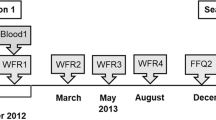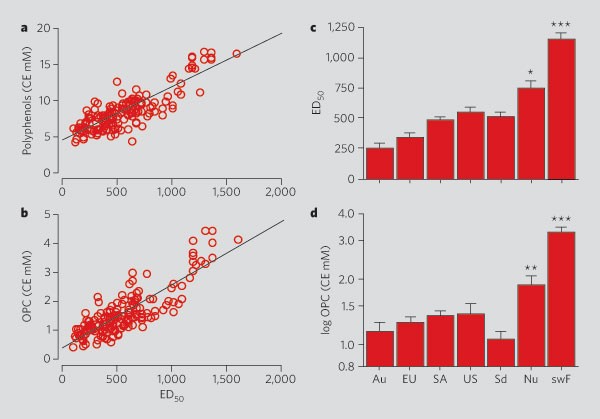
Regular, moderate consumption of red wine is linked to a reduced risk of coronary heart disease and to lower overall mortality 1 , but the relative contribution of wine's alcohol and polyphenol components to these effects is unclear 2 . Here we identify procyanidins as the principal vasoactive polyphenols in red wine and show that they are present at higher concentrations in wines from areas of southwestern France and Sardinia, where traditional production methods ensure that these compounds are efficiently extracted during vinification. These regions also happen to be associated with increased longevity in the population.



High consumption of polyphenols inhibits atherosclerosis in experimental models 3,4 . Red-wine polyphenols induce endothelium-dependent dilatation of blood vessels and suppress the synthesis of endothelin-1 (ET-1), a peptide that has a vasoconstricting effect 5,6,7 , and this may account for their anti-atherosclerotic activity. However, there is a lack of consensus on the protective effects of red wine, which may be due to variability in vasoactive constituents in different wines.
Red-wine polyphenols are a complex mixture of flavonoids (mainly anthocyanins and flavan-3-ols) and non-flavonoids (such as resveratrol and gallic acid). Flavan-3-ols are the most abundant, with oligomeric and polymeric procyanidins (condensed tannins) often representing 25–50% of the total phenolic constituents 8 .
We used cultured endothelial cells to identify the most potent vasoactive polyphenols in red wine (for methods, see supplementary information). These were shown by high-performance liquid chromatography with mass spectrometry 2 to be straight-chain B-type oligomeric procyanidins (OPCs) (tetra-epicatechin gallate, m/z = 1,305; procyanidin trimer-gallate, m/z = 1,017; procyanidin tetramer, m/z = 1,153; and pentamer-gallate, m/z = 1,593; see supplementary information).
Total polyphenols and OPC content of each wine correlated with the suppression of ET-1 synthesis (Fig. 1a, b). However, the linear regression plot for total polyphenols intercepted the y-axis at about 5 mM, which is consistent with most polyphenols (anthocyanins, catechins and resveratrol) lacking vasoactivity at the concentrations found in wine 5,7 .

To investigate how the OPC content of red wines from a particular region might relate to mortality in that region, we compared wines produced in areas of increased longevity (as an index of overall good health) with a broad selection of wines from different countries. People living in Nuoro province, Sardinia, have high longevity, particularly men 9 . In France, there are marked regional variations in mortality from coronary heart disease. We used the 1999 census data to identify unusual patterns of ageing in France (see supplementary information) and found that there are relatively more men aged 75 or over in the département of Gers in the Midi-Pyrenees in southwest France.
Grape seeds are the main source of OPCs but poor solubility, combined with oenological and viticultural factors, influence the amount of OPCs in wine 8 . The higher OPC concentration in wines from southwest France is due to traditional wine-making, which ensures that high amounts of OPCs are extracted, and to the flavonoid-rich grape Tannat, which makes up a large proportion of grapes used to produce local wines in the Gers area but is rarely grown elsewhere.
Absorption of OPCs and their identification in plasma has been demonstrated in vivo 10 , but little is known about their biological availability and metabolism. Further investigation of OPC-rich wines and foods should provide insight into how vascular function might be optimally maintained.